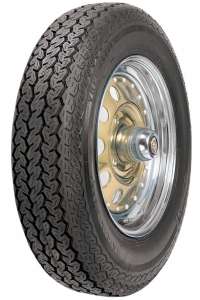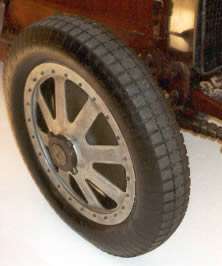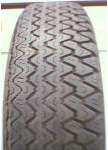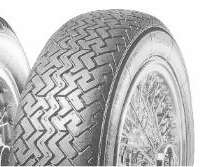The MGA With An Attitude
As to "racing" tires, there is a huge difference in grip and tread wear between race tires and street tires. On a grip scale from 1 to 10, all race tires are 9 or 10 (on dry pavement) while street tires range between 0 and 3 (yes there are a few 0's), and there is precious little in between. There are a few "Ultra High Performance" street tires that might merit a 5, but all low profile and wide requiring wheels larger in width and diameter. The smallest currently available race tire for a 15-inch wheel will be 205-50-15. The flip side of maximum grip is that real race tires have a tread life expectancy of maybe two to three hours on the track or about 5000-8000 miles of casual street use. They are also very expensive and no good at all on wet pavement, so you would normally reserve those for competition and drive something more civil on the street. Race tires are not hard to find. Go to any tire distributor web site and look for "Competition Tires". On 9/26/2011 +0000, Lin with Twin Cam YD3-1796 wrote:
Bill Spohn then asked the right question: "What do you do with your car? If you putter around town going to shows, rarely exceeding 4000 rpm, the Vredesteins will do just fine. If you actually drive the cars the way they were intended to be driven (and VERY few owners do this) then something better than the Vredesteins is in order, but it means adding an inch to the rim width". To which Lin replied: "While I do not plan on taking my car on track as a practice, some rallies like the Bluegrass 1000 have a stop at a speedway, so a safe reliable tire is important". Addendum September 6, 2017:
"Blockley tires are available in 550x15. I paid GBP 100 each. They are pleasingly high profile and at the same time are a softer compound than normal road tires. Has anyone experience of Blockley on post war MG's? Info is on their website". www.blockleytyre.com To which Lin replied: "I have Blockley tires for my PA. They're great looking, but I can't speak towards performance as I have not worked up the nerve to drive my PA aggressively enough to find out. I thought Blockley only produced tall-skinny tires. Do they run a block tread pattern or a modern zig-zag pattern"? Rod Green added: "I also use pre war skinny Blockleys, and they are great road/race tires (J2/Riley). Those on my twin cam are 5 stud [maybe 5-block?]. I'm hoping they will be a usable compromise between light competition and road. Michelin have their own specialist division producing competition tires for old cars. Avon produce a great high profile competition tyre which is FIA approved and great for MGB etc where one races under FIA rules. It would work on the road. Not pot holed African roads, though"!
"Do you know if the Coker Michelin tires are actually made by Michelin? Is it possible that Coker has the molds and the tires are made by another tire maker under license from Michelin"? Jonathan volunteered: "I think you are right about Coker having the molds and having the tires produced as needed. I somehow doubt Michelin is actually manufacturing them, but I can't be sure. It is probably a third party". Michelin XAS tires are still an option. These have an asymmetrical tread pattern, originally intended for better performance. If you drive them hard in competition, and the outside shoulder wears out early, you would not want to reverse them on the rim. These are no longer made by Michelin in these sizes. They are available from Coker Tire, for about five times the price of other modern radial tires, but I don't know who currently does the manufacturing. They were state of the art excellent tires when first produced in 1965. I haven't tried the reproduction Michelin tires recently, so I can't make a current judgment. From my past experience with Michelin XZX tires in the late 80s and early 90's, those tires were very long wearing, but not quite as good as others for road grip. In today's environment I don't suppose I would call these "competition" tires, but if you are vintage racing and the rules require vintage type tires, these may fill the bill.
"Pirelli makes a 175/70VR15 tire specifically for vintage racing classes in Europe. These are the old CN36 Cinturato, and I would prefer these over Michelin for a similar price ($249). However, these should really be mounted on a 5" rim. Don't be tempted to try the 155 series Pirelli. These are too small". So there you go, at least for a good start. All that chat in just a day or two, and some very good tips. You can spend a lot of time searching for the Holy Grail. |



